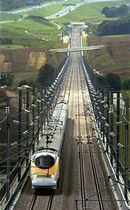 Matthew Sinclair’s piece on high-speed rail makes two main criticisms, both of which have already been addressed in the
material published earlier this week for the consultation – but I would like to explain our approach again here.
Matthew Sinclair’s piece on high-speed rail makes two main criticisms, both of which have already been addressed in the
material published earlier this week for the consultation – but I would like to explain our approach again here.
First, Matthew criticises our forecasts. He would prefer us not to forecast demand beyond 2026, but HS2 would be a long term investment and would bring benefits for successive generations over many
decades. It would be absurd to forecast only 10 years ahead. Therefore, we have taken a longer term but still realistic view. Demand for long distance rail travel more than doubled between 1994 and
2009 – an annual growth rate of around 5 percent. We have predicted a far slower growth rate than this: approximately 1.4 percent. And, as Matthew points out, we have allowed that demand may
not rise at the same rate forever and so have capped it in 2043; even though, in practice, it is highly unlikely that demand growth would simply come to a complete halt in this way.
His second criticism is that we have ignored the fact that travellers can use their time on the train productively. In fact, on page 51 of the Economic Case document, published as part of the consultation, we examine this issue in some detail. The clear reality is that
business travellers do value time savings. This is demonstrated by the fact that business people choose to fly, for example, between Glasgow and London, even though they could work more
productively and for longer on the train. And this approach underpins our overall analysis.
There is much criticism that we give too much weight to these journey time savings. However critics often ignore the counterfactual that we don’t adjust our models for lack of productivity
due to overcrowding. After all, little work is possible when you have to stand on a long train journey. There would be a small positive effect on the economic case for HS2 if we adjusted our models
to reflect this, as it would create substantial additional capacity. The alternative without HS2 would mean that opportunities to work productively on existing lines would decline as trains become
increasingly full in the future.
Alison Munro is Chief Executive of HS2






Comments